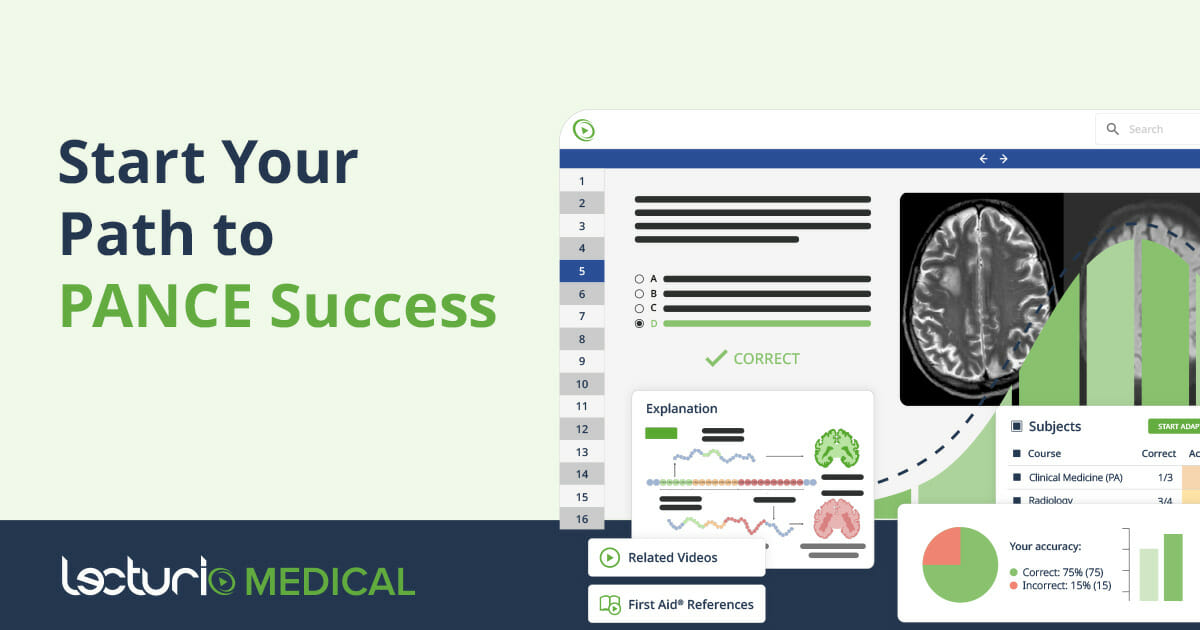What is PANCE?
The PANCE, or Physician Assistant National Certifying Exam, is self-explanatory. You take this exam to become a certified physician assistant (PA) after you finish your PA program. The test evaluates basic medical and surgical competencies expected of a PA. The exam content specifically covers two dimensions of medical content, each with its own allocation of topics:
- Diseases and disorders that physician assistants encounter
- Tasks or procedures performed on patients by physician assistants
I’ll cover the exact topics later in the article. The medical content only makes up 95% of the exam. The other 5% is dedicated to practice issues. However, up to 20% questions can be about surgical topics. While the exam may sound difficult given its scope, the passing rate has been somewhere above 90% for first-time takers. So, with the right review strategy, odds are, you’ll pass!
Is it different from PANRE?
The PANRE, or Physician Assistant National Recertifying Exam, is the exam you take to renew your certification. This is to ensure all physician assistants are up-to-date on the best practices for patient care.
Compared to the PANCE, this exam is slightly shorter. It consists of 240 questions in 4 blocks of 60 questions, to be completed in 4 hours. The exam is taken by physician assistants every 10th year on the maintenance cycle, but it can be taken as early as the 9th year.
Alternatively, there’s also the PANRE-LA that is administered in 12 quarters over the course of 3 years, starting from the 7th year of the maintenance cycle. It was designed to remove much of the anxiety that comes with the PANRE. It allows PAs to use their own devices to answer questions at their own convenience.
What is a physician assistant?
A physician assistant examines, diagnoses, and manages patients under the supervision of a licensed physician. They can assist in operations, prescribe medications, interpret lab tests, and counsel patients.
Due to the increased demand for medical practitioners, the field is becoming more widely-accepted in other countries (with varying scope of practice). Physician assistants improve thousands of people’s access to quality healthcare, especially those in underprivileged areas. While they work under supervision, they can still perform a wide range of tasks with some autonomy.
While a relatively new field, studies show that many patients are satisfied with the care from physician assistants and believe that they help solve the shortage of healthcare workers in the United States.
How is this different from a doctor?
Since they both specialize in general medicine and most of them work in primary care settings, general practitioners and physician assistants have many similarities in terms of tasks.
Of course, there are some differences. Doctors can perform a wider range of medical tasks with no need for supervision. They also have more options for specializations like radiology, obstetrics and gynecology, pediatrics, etc. While both jobs require you to be certified, the educational requirements are different. A doctor requires 4–5 years of medical school, while a physician assistant requires a master’s degree in an accredited PA university program.
How is this different from a nurse practitioner (NP)?
One important difference is the training. NPs and PAs share some tasks such as consulting, diagnosing, and treating diseases, and they both work closely with doctors. However, where physician assistants are trained with a curriculum based on medical schools, nurse practitioners are trained in the practice of nursing. Another difference is that physician assistants practice in general medicine, while nurse practitioners choose a “population focus.”
How do you qualify to take the PANCE?
In order to be eligible to take the PANCE, you need to be a graduate from any PA program accredited by the Accreditation Review Commission on Education for the Physician Assistant (ARC-PA). After graduation, you need to show proof that you’re eligible to take the PANCE to the National Commission on Certification of Physician Assistants (NCCPA), who will then verify your graduation date and program. The verification period can take some time, so some recommend that you choose a testing date at least 4 weeks after your graduation. Of course, you can take your time reviewing and take it later, but make sure that you take the PANCE within 6 years after graduating from your PA program! Otherwise, you’ll no longer be eligible.
When do you take the PANCE?
You can usually find the administration window for the PANCE on the NCCPA site itself. The earliest you can apply for the PANCE is 180 days (around 6 months) before your PA program is completed. Then, the earliest you can take the PANCE is 7 days after your PA program is completed.
In terms of scheduling, it’s recommended that you take the exam as soon as you can. Although you deserve to take time off if you want, you don’t want to wait too long. You’ll want to have the knowledge from your PA program still fresh in your mind. On the other hand, you’ll also want to consider how much time you want to take to review for the PANCE. So, find that sweet spot where you’re late enough to prepare and study, but not so late that you’ll lose your momentum.
Many students take the exam 10–20 days after graduating.
How do I register for the PANCE?
To register for PANCE, you need to submit an application and pay a $550 fee. Then, NCCPA will verify your graduation date and the program from which you graduated. After you’ve been verified, you’ll receive your exam permit through your registered email. This permit will remain valid until the end of your examination window.
After receiving the permit, NCCPA will notify Pearson VUE Test Centers of your eligibility. This will take at least 3 days, so wait a few days before scheduling your exam date. Plan ahead as much as possible and make sure that no major events happen between your application date and your exam so that you can prepare properly.
What are the contents of the PANCE?
The PANCE is a multiple-choice exam consisting of 300 questions, taken in 5 blocks with 60 questions each. Test-takers are allotted 60 minutes for each block, so you’ll have 5 hours in total to take the exam.
For the up-to-date content outline, refer to the blueprint on the NCCPA website.
In terms of diseases, each system in the human body has a percent allocated to it. The highest allocations are given to Cardiovascular (13%), Pulmonary (10%), and Gastrointestinal or Nutrition (10%). This is because these would be the more common reasons why patients seek care from physician assistants.
For the tasks, the highest percentages are allocated to formulating the most likely diagnosis (18%), history-taking and physical examination (17%), clinical intervention (14%), and pharmaceutical therapeutics (14%).

Prepare for the PANCE with Lecturio
Start your path to PANCE success with an all-in-one study platform
What happens on exam day?
The PANCE will be administered in segments called “exam blocks” that you must go through one-by-one. In each block, you can answer the questions in any order. However, once you exit the block or the time expires, you can no longer go back to your answers. So, make sure that you give yourself ample time to review your answers!
There are 5 exam blocks with 60 minutes allotted for each. You’ll also have 45 minutes in-between. Manage your break time well, because exceeding it will result in a deduction from your overall exam time! Remember to arrive at least 30 minutes early for your exam, well-rested and ready for the long day ahead.
At the site, you’ll have to present two valid and current IDs. Your name must match your name listed with the NCCPA. If your name changes in between your application date and exam, like if you changed it or got married, you need to inform the NCCPA. Apart from the IDs, you can’t bring personal items with you to the testing room, but you can access them during your breaks.
The PANCE passing score
Unlike exams like the MCAT, which don’t have a specific “passing” score, PANCE has a predetermined passing score of 350 or higher. The highest score you can get is 800, while the minimum is 200.
The NCCPA determined the passing score through a process called “standard setting.” This involved having an expert panel review the test questions and decide on essential topics that a competent PA must know. The panel rates each exam question, and these ratings were used to come up with a recommended cutoff score.
Results usually come out 4–14 days after you take the exam.
How often can I take the PANCE?
Should you fail the PANCE on your first attempt, you can retake it. However, there is a limit to the number of retakes: You can retake the PANCE up to 6 times within 6 years after graduating from your PA program.




